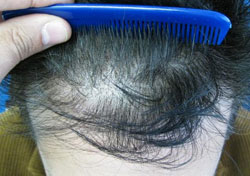Hair transplant, despite its many success stories, is still a fairly new procedure. So, it is not surprising that some people still question its safety, especially when you hear terms like “hair transplant shock loss” being thrown around like it is part of the whole deal. What is hair transplant shock loss and how does one deal with it when it happens?

Understanding What a “Shock Loss” Means
Hair transplant shock loss is a temporary condition. And as the name implies, the hairs will appear “shocked” in response to trauma incurred during transplantation. This phenomenon leads to the temporary loss of hair in the donor or the recipient areas of the scalp. Temporary shock loss occurs in no definite pattern. Sometimes, the shock loss can be permanent, but it is a rarity. This is often termed as “transplant induced shedding” and it usually occurs two to three months after the surgery. It is considered a normal phenomenon, but since it does not exactly produce great effects, patients and doctors would want to veer away from ever having to deal with it.
The Causes of Permanent Shock Loss
As mentioned, permanent shock loss is rare but its effects are more catastrophic. It is brought about by several things, such as:
- If you undergo the procedure in the care of an inexperienced surgeon whose hands are not skilled enough to handle such a technique-sensitive and delicate procedure.
- If your surgeon is skilled but the instruments and equipment used are not up-to-date, larger and unrefined, the incisions will be bigger and the procedure will be more invasive.
- If the hairs have unfortunately reached miniaturization and Propecia (Finasteride) is not taken, the hairs will be too weak to support the transplantation and they will be shed, even before new growth is enhanced.
How to Prevent Shock Loss
It is often said that (and this one is true for many things) “prevention is better than cure.” So, instead of having to deal with the frustrating effects of a hair transplant shock loss, it is so much better if you veer away from it. Avoiding a problem will be easier than finding a solution to it, so take note of the following prevention tips that you can use:
- Make sure to choose a doctor that uses an ultra refine follicular transplantation units so that the incisions and cuts to be made on the scalp will be very conservative and refined.
- Take Propecia (Finasteride) to enhance healing and to avoid the hastened miniaturization of the donor hairs (but make sure you have your doctor’s permission)
- Make sure that your doctor is conservative with the transplantation, and that he observes super dense packing at the area of transplantation.
The “shocked” hair will grow in time and your head will sport its new hair. Oftentimes, patience is going to be the most important virtue you have to develop after your hair transplant surgery because it is a lengthy process that requires you to do a lot of waiting.
